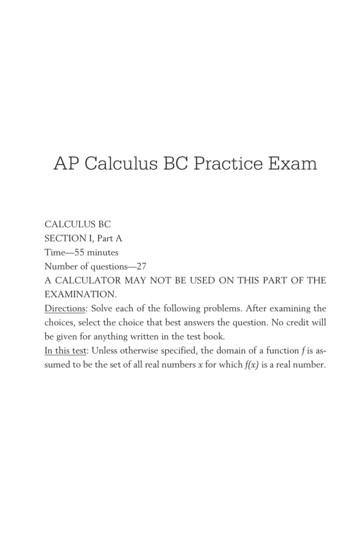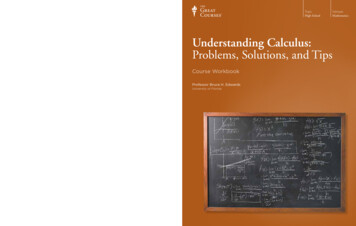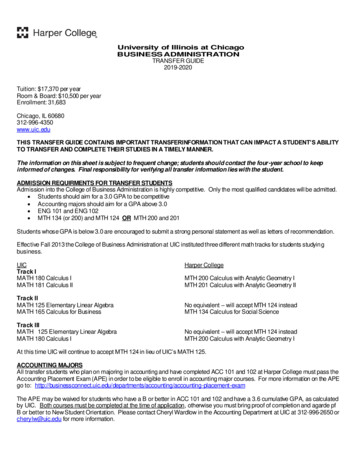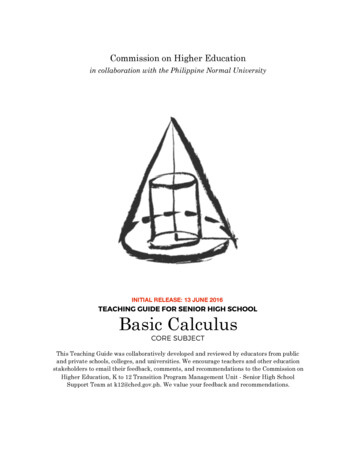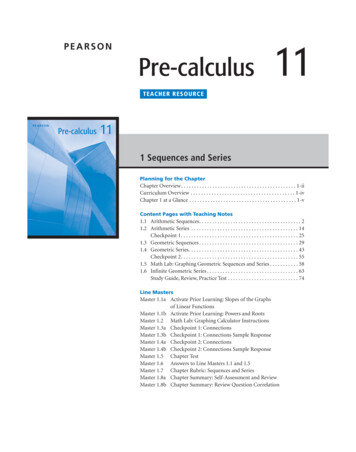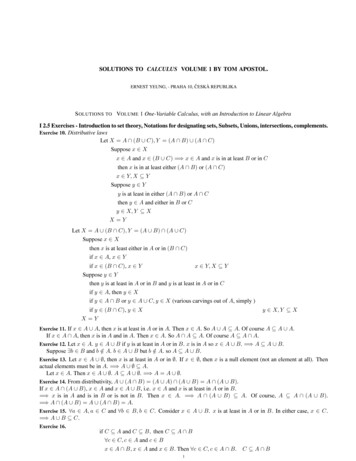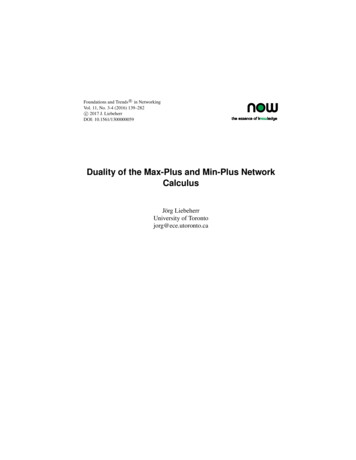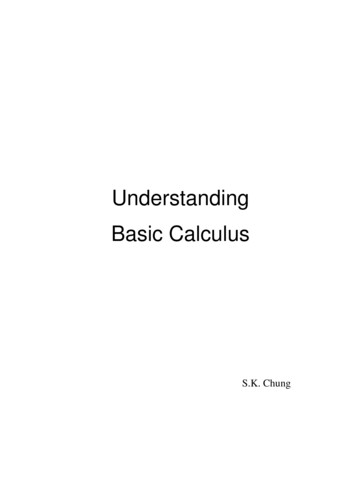
Transcription
UnderstandingBasic CalculusS.K. Chung
Dedicated to all the people who have helped me in my life.
iPrefaceThis book is a revised and expanded version of the lecture notes for Basic Calculus and other similar coursesoffered by the Department of Mathematics, University of Hong Kong, from the first semester of the academicyear 1998-1999 through the second semester of 2006-2007. It can be used as a textbook or a reference bookfor an introductory course on one variable calculus.In this book, much emphasis is put on explanations of concepts and solutions to examples. By readingthe book carefully, students should be able to understand the concepts introduced and know how to answerquestions with justification. At the end of each section (except the last few), there is an exercise. Studentsare advised to do as many questions as possible. Most of the exercises are simple drills. Such exercises maynot help students understand the concepts; however, without practices, students may find it difficult to continuereading the subsequent sections.Chapter 0 is written for students who have forgotten the materials that they have learnt for HKCEE Mathematics. Students who are familiar with the materials may skip this chapter.Chapter 1 is on sets, real numbers and inequalities. Since the concept of sets is new to most students, detailexplanations and elaborations are given. For the real number system, notations and terminologies that willbe used in the rest of the book are introduced. For solving polynomial inequalities, the method will be usedlater when we consider where a function is increasing or decreasing as well as where a function is convex orconcave. Students should note that there is a shortcut for solving inequalities, using the Intermediate ValueTheorem discussed in Chapter 3.Chapter 2 is on functions and graphs. Some materials are covered by HKCEE Mathematics. New conceptsintroduced include domain and range (which are fundamental concepts related to functions); composition offunctions (which will be needed when we consider the Chain Rule for differentiation) and inverse functions(which will be needed when we consider exponential functions and logarithmic functions).In Chapter 3, intuitive idea of limit is introduced. Limit is a fundamental concept in calculus. It is usedwhen we consider differentiation (to define derivatives) and integration (to define definite integrals). There aremany types of limits. Students should notice that their definitions are similar. To help students understandsuch similarities, a summary is given at the end of the section on two-sided limits. The section of continuousfunctions is rather conceptual. Students should understand the statements of the Intermediate Value Theorem(several versions) and the Extreme Value Theorem.In Chapters 4 and 5, basic concepts and applications of differentiation are discussed. Students who knowhow to work on limits of functions at a point should be able to apply definition to find derivatives of “simple”functions. For more complicated ones (polynomial and rational functions), students are advised not to usedefinition; instead, they can use rules for differentiation. For application to curve sketching, related conceptslike critical numbers, local extremizers, convex or concave functions etc. are introduced. There are many easilyconfused terminologies. Students should distinguish whether a concept or terminology is related to a function,to the x-coordinate of a point or to a point in the coordinate plane. For applied extremum problems, students
iishould note that the questions ask for global extremum. In most of the examples for such problems, more thanone solutions are given.In Chapter 6, basic concepts and applications of integration are discussed. We use limit of sums in a specificform to define the definite integral of a continuous function over a closed and bounded interval. This is to makethe definition easier to handle (compared with the more subtle concept of “limit” of Riemann sums). Sincedefinite integrals work on closed intervals and indefinite integrals work on open intervals, we give differentdefinitions for primitives and antiderivatives. Students should notice how we can obtain antiderivatives fromprimitives and vice versa. The Fundamental Theorem of Calculus (several versions) tells that differentiationand integration are reverse process of each other. Using rules for integration, students should be able to findindefinite integrals of polynomials as well as to evaluate definite integrals of polynomials over closed andbounded intervals.Chapters 7 and 8 give more formulas for differentiation. More specifically, formulas for the derivatives ofthe sine, cosine and tangent functions as well as that of the logarithmic and exponential functions are given.For that, revision of properties of the functions together with relevant limit results are discussed.Chapter 9 is on the Chain Rule which is the most important rule for differentiation. To make the ruleeasier to handle, formulas obtained from combining the rule with simple differentiation formulas are given.Students should notice that the Chain Rule is used in the process of logarithmic differentiation as well as thatof implicit differentiation. To close the discussion on differentiation, more examples on curve sketching andapplied extremum problems are given.Chapter 10 is on formulas and techniques of integration. First, a list of formulas for integration is given.Students should notice that they are obtained from the corresponding formulas for differentiation. Next, severaltechniques of integration are discussed. The substitution method for integration corresponds to the Chain Rulefor differentiation. Since the method is used very often, detail discussions are given. The method of Integrationby Parts corresponds to the Product Rule for differentiation. For integration of rational functions, only somespecial cases are discussed. Complete discussion for the general case is rather complicated. Since Integrationby Parts and integration of rational functions are not covered in the course Basic Calculus, the discussion onthese two techniques are brief and exercises are not given. Students who want to know more about techniques ofintegration may consult other books on calculus. To close the discussion on integration, application of definiteintegrals to probability (which is a vast field in mathematics) is given.Students should bear in mind that the main purpose of learning calculus is not just knowing how to performdifferentiation and integration but also knowing how to apply differentiation and integration to solve problems.For that, one must understand the concepts. To perform calculation, we can use calculators or computer softwares, like Mathematica, Maple or Matlab. Accompanying the pdf file of this book is a set of Mathematicanotebook files (with extension .nb, one for each chapter) which give the answers to most of the questions in theexercises. Information on how to read the notebook files as well as trial version of Mathematica can be foundat http://www.wolfram.com .
Contents01234Revision0.1 Exponents . . . . . . . . . . . . . . . . . . . . . .0.2 Algebraic Identities and Algebraic Expressions . .0.3 Solving Linear Equations . . . . . . . . . . . . . .0.4 Solving Quadratic Equations . . . . . . . . . . . .0.5 Remainder Theorem and Factor Theorem . . . . .0.6 Solving Linear Inequalities . . . . . . . . . . . . .0.7 Lines . . . . . . . . . . . . . . . . . . . . . . . .0.8 Pythagoras Theorem, Distance Formula and Circles0.9 Parabola . . . . . . . . . . . . . . . . . . . . . . .0.10 Systems of Equations . . . . . . . . . . . . . . . .1124681012171920Sets, Real Numbers and Inequalities1.1 Sets . . . . . . . . . . . . . . . . . . . . . . . .1.1.1 Introduction . . . . . . . . . . . . . . . .1.1.2 Set Operations . . . . . . . . . . . . . .1.2 Real Numbers . . . . . . . . . . . . . . . . . . .1.2.1 The Number Systems . . . . . . . . . . .1.2.2 Radicals . . . . . . . . . . . . . . . . . .1.3 Solving Inequalities . . . . . . . . . . . . . . . .1.3.1 Quadratic Inequalities . . . . . . . . . .1.3.2 Polynomial Inequalities with degrees 3.23232328323234373839Functions and Graphs2.1 Functions . . . . . . . . . . . . .2.2 Domains and Ranges of Functions2.3 Graphs of Equations . . . . . . .2.4 Graphs of Functions . . . . . . . .2.5 Compositions of Functions . . . .2.6 Inverse Functions . . . . . . . . .2.7 More on Solving Equations . . . .4343454953646669Limits3.1 Introduction . . . . . . . . . .3.2 Limits of Sequences . . . . . .3.3 Limits of Functions at Infinity3.4 One-sided Limits . . . . . . .3.5 Two-sided Limits . . . . . . .3.6 Continuous Functions . . . . .73737580868994.Differentiation1034.1 Derivatives . . . . . . . . . . . . . . . . . . . . . . . . . . . . . . . . . . . . . . . . . . . . . . . . . . 1034.2 Rules for Differentiation . . . . . . . . . . . . . . . . . . . . . . . . . . . . . . . . . . . . . . . . . . . 1104.3 Higher-Order Derivatives . . . . . . . . . . . . . . . . . . . . . . . . . . . . . . . . . . . . . . . . . . . 123
ivCONTENTS5 Applications of Differentiation5.1 Curve Sketching . . . . . . . . . . . . . . . .5.1.1 Increasing and Decreasing Functions5.1.2 Relative Extrema . . . . . . . . . . .5.1.3 Convexity . . . . . . . . . . . . . . .5.1.4 Curve Sketching . . . . . . . . . . .5.2 Applied Extremum Problems . . . . . . . . .5.2.1 Absolute Extrema . . . . . . . . . . .5.2.2 Applied Maxima and Minima . . . .5.2.3 Applications to Economics . . . . . .1271281281311361431461461481536 Integration6.1 Definite Integrals . . . . . . . . .6.2 Fundamental Theorem of Calculus6.3 Indefinite Integrals . . . . . . . .6.4 Application of Integration . . . . .157157162167173.7 Trigonometric Functions1797.1 Angles . . . . . . . . . . . . . . . . . . . . . . . . . . . . . . . . . . . . . . . . . . . . . . . . . . . . . 1797.2 Trigonometric Functions . . . . . . . . . . . . . . . . . . . . . . . . . . . . . . . . . . . . . . . . . . . 1807.3 Differentiation of Trigonometric Functions . . . . . . . . . . . . . . . . . . . . . . . . . . . . . . . . . . 1878 Exponential and Logarithmic Functions1918.1 Exponential Functions . . . . . . . . . . . . . . . . . . . . . . . . . . . . . . . . . . . . . . . . . . . . 1918.2 Logarithmic Functions . . . . . . . . . . . . . . . . . . . . . . . . . . . . . . . . . . . . . . . . . . . . 1968.3 Differentiation of Exp and Log Functions . . . . . . . . . . . . . . . . . . . . . . . . . . . . . . . . . . 2019 More Differentiation9.1 Chain rule . . . . . . . . .9.2 Implicit Differentiation . .9.3 More Curve Sketching . .9.4 More Extremum Problems.20720721521922210 More Integration10.1 More Formulas . . . . . . . . . . . . .10.2 Substitution Method . . . . . . . . . . .10.3 Integration of Rational Functions . . . .10.4 Integration by Parts . . . . . . . . . . .10.5 More Applications of Definite Integrals.229229232240246248.A AnswersB Supplementary NotesB.1 Mathematical Induction . . . . . .B.2 Binomial Theorem . . . . . . . .B.3 Mean Value Theorem . . . . . . .B.4 Fundamental Theorem of Calculus255.269269271274276
Chapter 0Revision0.1ExponentsDefinition(1) Let n be a positive integer and let a be a real number. We define an to be the real number given byan aa · · ·}a. · {zn factors(2) Let n be a negative integer n, that is, n k where k is a positive integer, and let a be a real numberdifferent from 0. We define a k to be the real number given bya k (3)1.ak(i) Let a be a real number different from 0. We define a0 1.(ii) We do not define 00 (thus the notation 00 is meaningless).Terminology In the notation an , the numbers n and a are called the exponent and base respectively.Rules for Exponents Let a and b be real numbers and let m and n be integers (when a 0 or b 0, we haveto add the condition: m, n different from 0). Then we have(1) am an am nam am nan(3) (am )n amnprovided that a , 0(2)(4) (ab)n an bn a n an(5) nbbprovided that b , 0Exercise 0.11. Simplify the following; give your answers without negative exponents.(a)(c)x6 x 3 x 2 y3(b) 4(d)x 1 y2z 3 3 22x2 y4 x 1 y
2Chapter 0. Revision0.2 Algebraic Identities and Algebraic ExpressionsIdentities Let a and b be real numbers. Then we have(1) (a b)2 a2 2ab b2(2) (a b)2 a2 2ab b2(3) (a b)(a b) a2 b2Remark The above equalities are called identities because they are valid for all real numbers a and b.Caution In general, (a b)2 , a2 b2 .Note: (a b)2 a2 b2 if and only if a 0 or b 0.Example Expand the following: 2(1)x 2!25(2) x x (3)x2 1 7x2 1 7Solution 2 2 (1)x 2 x 2 x (2) 22 x 4 x 4(2)5x x!2 x2!!255 2(x)xx25x2 2x2 1 7x2 1 7 x 2 1 72 x2 1 49 x2 10 (3) x2 48 Example Simplify the following:(1)x2 x 6x2 6x 9x2 1x2 121(3) 2 2x 2x 1 x x 2 1(4) x y 1(2)(5)6xxx 13 x
0.2. Algebraic Identities and Algebraic Expressions3Solution(1)(2)x2 x 6x2 6x 9 (x 3)(x 2)(x 3)2 x 2x 3x2 1 x2 1 (3)(4)x21 121 x2 2x 1 x2 x 2 x y 1 16xxx 13 x 1y 21 (x 1)2 (x 1)(x 2) 2(x 2) (x 1)(x 1)2 (x 2) x 5(x 1)2 (x 2)! 1 x xy 1y (5)x2 (x2 1)x2 1! 1yxy 1 3x 6xx (x 1) xx 1 3x 6xx2 2xx 1 x 13(x 2)·xx (x 2) 3(x 1)x2 FAQ What is expected if we are asked to simplify an expression? For example, in (5), can we givethe answer?Answer There is no definite rule to tell which expression is simpler. For (5), bothacceptable. Use your own judgment.3(x 1)x2and3x 3x23x 3x2asare
4Chapter 0. RevisionExercise 0.21. Expand the following:(a)(c)(e)(2x 3)2(x 3y)(x 3y) 22 x 3(b)(d)(f)(3x y)2(x 3y)(x 4y) x 5x 52. Factorize the following:(a)(c)(e)(g)x2 7x 12x2 8x 169x2 6x 13x2 18x 27(b)(d)(f)(h)x2 x 69x2 9x 25x2 52x2 12x 163. Simplify the following:(a)x2 x 6x2 7x 12(c)4x2 4x2x x 1x2 1(b)(d)x2 3x 42 x x211 x hxh0.3 Solving Linear EquationsA linear equation in one (real) unknown x is an equation that can be written in the formax b 0,where a and b are constants with a , 0 (in this course, we consider real numbers only; thus a “constant” meansa real number that is fixed or given). More generally, an equation in one unknown x is an equation that can bewritten in the formF(x) 0(0.3.1)Remark To be more precise, F should be a function from a subset of R into R. See later chapters for themeanings of “function” and “R”.Definition A solution to Equation (0.3.1) is a real number x0 such that F(x0 ) 0.32Example The equation 2x 3 0 has exactly one solution, namely .To solve an equation (in one unknown) means to find all solutions to the equation.Definition We say that two equations are equivalent if the have the same solution(s).Example The following two equations are equivalent:(1) 2x 3 0(2) 2x 3To solve an equation, we use properties of real numbers to transform the given equation to equivalent onesuntil we obtain an equation whose solutions can be found easily.
0.3. Solving Linear Equations5Properties of real numbers Let a, b and c be real numbers. Then we have(1) a b a c b c(2) a b ac bc and ac bc a b if c , 0Remark is the symbol for “implies”. The first part of Property (2) means that if a b, then ac bc. is the symbol for “ and ”. Property (1) means that if a b, then a c b c and vice versa,that is, a b iff a c b c. In mathematics, we use the shorthand “iff ” to stand for “if and only if ”.Example Solve the following equations for x.(1) 3x 5 2(7 x)(2) a(b x) c dx, where a, b, c and d are real numbers with a d , 0.Solution(1) Using properties of real numbers, we get3x 5 2(7 x)3x 5 14 2x3x 2x 14 55x 19x The solution is19.519.5FAQ Can we omit the last sentence?19Answer The steps above means that a real number x satisfies 3x 5 2(7 x) if and only if x .5It’s alright if you stop at the last line in the equation array because it tells that given equation has one and19only one solution, namely . 5FAQ What is the difference between the word “solution” after the question and the word “solution” inthe last sentence?Answer They refer to different things. The first “solution” is solution (answer) to the problem (how tosolve the problem) whereas the second “solution” means solution to the given equation. Sometimes, anequation may have no solution, for example, x2 1 0 but the procedures (explanations) to get thisinformation is a solution to the problem. FAQ Can we use other symbols for the unknown?Answer In the given equation, if x is replaced by another symbol, for example, t, we get the equation193t 5 2(7 t) in one unknown t. Solution to this equation is also . In writing an equation, the symbol5
6Chapter 0. Revisionfor the unknown is not important. However, if the unknown is expressed in t, all the intermediate stepsshould use t as unknown:3t 5 2(7 t).t 195 (2) Using properties of real numbers, we geta(b x) c dxab ax c dxax dx c ab(a d)x c abx c ab.a d Exercise 0.31. Solve the following equations for x.(a)2(x 4) 7x 2(b)(c)(a b)x x2 (x b)2(d)5x 35x 4 5 24x x ca bwhere a, b and c are constants with a , b.0.4 Solving Quadratic EquationsA quadratic equation (in one unknown) is an equation that can be written in the formax2 bx c 0(0.4.1)where a, b, and c are constants and a , 0. To solve (0.4.1), we can use the Factorization Method or theQuadratic Formula.Factorization MethodThe method makes use of the following result on product of real numbers:Fact Let a and b be real numbers. Then we haveab 0 a 0 or b 0.Example Solve x2 2x 15 0.Solution Factorizing the left side, we obtain(x 5)(x 3) 0.Thus x 5 0 or x 3 0. Hence x 5 or x 3.
0.4. Solving Quadratic Equations7FAQ Can we write “x 5 and x 3”?Answer The logic in solving the above equation is as followsx2 2x 15 0 (x 5)(x 3) 0 x 5 0 or x 3 0 x 5 or x 3It means that a (real) number x satisfies the given equation if and only if x 5 or x 3. The statement“x 5 or x 3” cannot be replaced by “x 5 and x 3”.To say that there are two solutions, you may write “the solutions are 5 and 3”. Sometimes, we also write“the solutions are x1 5 and x2 3” which means “there are two solutions 5 and 3 and they are denotedby x1 and x2 respectively”.In Chapter 1, you will learn the concept of sets. To specify a set, we may use “listing” or “description”.The solution set to an equation is the set consisting of all the solutions to the equation. For the above example,we may write the solution set is { 5, 3} (listing); the solution set is {x : x 5 or x 3}(description).When we use and, we mean the listing method.Quadratic Formula Solutions to Equation (0.4.1) are given by b b2 4ac.x 2aRemark b2 4ac is called the discriminant of (0.4.1).(1) If b2 4ac 0, then (0.4.1) has two distinct solutions.(2) If b2 4ac 0, then (0.4.1) has one solution.(3) If b2 4ac 0, then (0.4.1) has no (real) solution.FAQ Why is “(real)” added?Answer When the real number system is enlarged to the complex number system, (0.4.1) has two complexsolutions if b2 4ac 0. However, these solutions are not real numbers. In this course, we consider realnumbers only. So you may simply say that there is no solution. Example Solve the following quadratic equations.(1) 2x2 9x 10 0(2) x2 2x 3 0Solution(1) Using the quadratic formula, we see that the equation has two solutions given byp9 ( 9)2 4(2)(10) 9 1x .2(2)4
8Chapter 0. RevisionThus the solutions are52and 2.(2) Since 22 4(1)(3) 8 0, the equation has no solutions. Example Solve the equation x (x 2) x (2x 3).Solution Expanding both sides, we getx2 2x 2x2 3xx2 x 0x (x 1) 0x 0 or x 1The solutions are 1 and 0. Remark If we cancel the factor x on both sides, we get x 2 2x 3 which has only one solution. In cancelingthe factor x, it is assumed that x , 0. However, 0 is a solution and so this solution is lost. To use cancellation,we should writex (x 2) x (2x 3) x 2 2x 3 or x 0.Example Find the value(s) of k such that the equation 3x2 kx 7 0 has only one solution.Solution The given equation has only one solution iffk2 4(3)(7) 0. Solving, we get k 84. Exercise 0.41. Solve the following equations.(a)(c)(e)4x 4x2 04x (x 4) x 15 x2 2 2x 3 0(b)(d)(f)2 x 3x2 0 x2 2 2x 2 0x3 7x2 3x 02. Find the value(s) of k such that the equation x2 kx (k 3) 0 has only one solution.3. Find the positive number such that sum of the number and its square is 210.0.5 Remainder Theorem and Factor TheoremRemainder Theorem If a polynomial p(x) is divided by x c, where c is a constant, the remainder is p(c).Example Let p(x) x3 3x2 2x 2. Find the remainder when p(x) is divided by x 2.Solution The remainder is p(2) 23 3(22 ) 2(2) 2 18.Factor Theorem (x c) is a factor of a polynomial p(x) if and only if p(c) 0.
0.5. Remainder Theorem and Factor Theorem9Proof This follows immediately from the remainder theorem because (x c) is a factor means that the remainderis 0. Example Let p(x) x3 kx2 x 6. Suppose that (x 2) is a factor of p(x).(1) Find the value of k.(2) With the value of k found in (1), factorize p(x).Solution (1) Since x ( 2) is a factor of p(x), it follows from the Factor Theorem that p( 2) 0, that is( 2)3 k( 2)2 ( 2) 6 0.Solving, we get k 4.(2) Using long division, we getx3 4x2 x 6 (x 2)(x2 2x 3).By inspection, we have p(x) (x 2)(x 3)(x 1). FAQ Can we find the quotient (x2 2x 3) by inspection (without using long division)?Answer The “inspection method” that some students use is called the compare coefficient method. Since thequotient is quadratic, it is in the form (ax2 bx c). Thus we havex3 4x2 x 6 (x 2)(ax2 bx c)(0.5.1)Comparing the coefficient of x3 , we see that a 1. Similarly, comparing the constant term, we get c 3.Hence we havex3 4x2 x 6 (x 2)(x2 bx 3).To find b, we may compare the x2 term (or the x term) to get4 2 b,which yields b 2.Remark The compare coefficient method in fact consists of the following steps:(1) Expand the right side of (0.5.1) to getax3 (2a b)x2 (2b c)x 2c(2) Compare the coefficients of the given polynomial with that obtained in Step (1) to get1 a4 2a b1 2b c 6 2c
10Chapter 0. Revision(3) Solve the above system to find a, b and c. Example Factorize p(x) 2x2 3x 1.Solution Solving p(x) 0 by the quadratic formula, we getp ( 3) ( 3)2 4(2)( 1) 3 17x .2(2)4 3 17 3 17 By the Factor Theorem, both x and x are factors of p(x). Therefore, we have44 p(x) 2 x 3 174!x !3 174where the factor 2 is obtained by comparing the leading term (that is, the x2 term). FAQ Can we say that p(x) can’t be factorized?Answer Although p(x) does not have factors in the form (x c) where c is an integer, it has linear factors asgiven above. If the question asks for factors with integer coefficients, then p(x) cannot be factorized as productof linear factors. FAQ Can we use the above method to factorize, for example, p(x) 6x2 x 2 ?Answer If you don’t know how to factorize p(x) by inspection, you can solve p(x) 0 using the quadratic12formula (or calculators) to get x or x . Therefore (by the Factor Theorem and comparing the leading23term), we have 21x p(x) 6 x 23 (2x 1)(3x 2). Exercise 0.51. For each of the following expressions, use the factor theorem to find a linear factor (x c) and hencefactorize it completely (using integer coefficients).(a)(c)x3 13x 122x3 x2 4x 3(b)(d)2x3 7x2 2x 3x3 5x2 11x 72. Solve the following equation for x.(a)(c)2x3 9x2 8x 15 02x3 5x2 2x 15 0(b)x3 2x 1 00.6 Solving Linear InequalitiesNotation and Terminology Let a and b be real numbers.(1) We say that b is greater than a, or equivalently, that a is less than b to mean that b a is a positivenumber.
0.6. Solving Linear Inequalities11(2) We write b a to denote that b is greater than a and we write a b to denote that a is less than b.(3) We write b a to denote that b is greater than or equal to a and we write a b to denote that a is lessthan or equal to b.A linear inequality in one unknown x is an inequality that can be written in one of the following forms:(1) ax b 0(2) ax b 0(3) ax b 0(4) ax b 0where a and b are constants with a , 0. More generally, an inequality in one unknown x is an inequality thatcan be written in one of the following forms:(1) F(x) 0(2) F(x) 0(3) F(x) 0(4) F(x) 0where F is a function from a subset of R into R.Definition A solution to an inequality F(x) 0 is a real number x0 such that F(x0 ) 0. The definition alsoapplies to other types of inequalities.Example Consider the inequality 2x 3 0. By direct substitution, we see that 1 is a solution and 2 is not asolution.To solve an inequality means to find all solutions to the inequality.Rules for Inequalities Let a, b and c be real numbers. Then the following holds.(1) If a b, then a c b c.(2) If a b and c 0, then ac bc.(3) If a b and c 0, then ac bc. Note: The inequality is reversed.(4) If a b and b c, then a c.(5) If a b and a and b have the same sign, then1a1b .(6) If 0 a b and n is a positive integer, then an bn and na nb.Terminology Two numbers have the same sign means that both of them are positive or both of them are negative.Remark One common mistake in solving inequalities is to apply a rule with the wrong sign (positive ornegative). For example, if c is negative, it would be wrong to apply Rule (2).Example Solve the following inequalities.(1) 2x 1 7(x 3)
12Chapter 0. Revision(2) 3(x 2) 5 3x 7Solution(1) Using rules for inequalities, we get2x 12x 11 21 20 4 7(x 3)7x 217x 2x5xx.The solutions are all the real numbers x such that x 4, that is, all real numbers less than 4.(2) Expanding the left side, we get3(x 2) 5 3x 1which is always less than the right side. Thus the inequality has no solution. Exercise 0.61. Solve the following inequalities for x.(a)(c)1 x 3x 7 233x 3 01 x(b) 2(3 x) 3(1 x)(d)2x 12x 30.7 LinesA linear equation in two unknowns x and y is an equation that can be written in the formax by c 0(0.7.1)where a, b and c are constants with a, b not both 0. More generally, an equation in two unknowns x and y is anequation that can be written in the formF(x, y) 0,(0.7.2)where F is a function (from a collection of ordered pairs into R).Definition An ordered pair (of real numbers) is a pair of real numbers x0 , y0 enclosed inside parenthesis:(x0 , y0 ).Remark Two ordered pairs (x0 , y0 ) and (x1 , y1 ) are equal if and only if x0 x1 and y0 y1 . For example, theordered pairs (1, 2) and (2, 1) are not equal.Definition A solution to Equation (0.7.2) is an ordered pair (x0 , y0 ) such that F(x0 , y0 ) 0.Example Consider the equation2x 3y 4 0.By direct substitution, we see that (2, 0) is a solution whereas (1, 2) is not a solution.
0.7. Lines13Rectangular Coordinate System Given a plane, there is a one-to-one correspondence between points in theplane and ordered pairs of real numbers (see the construction below). The plane described in this way is calledthe Cartesian plane or the rectangular coordinate plane.First we construct a horizontal line and a vertical line on the plane.Their point of intersection is called the origin. The horizontal lineis called the x-axis and the vertical line y-axis. For each point Pin the plane we can label it by two real numbers. To this ends, wedraw perpendiculars from P to the x-axis and y-axis. The f
Chapter 0 Revision 0.1 Exponents Definition (1) Let n be a positive integer and let a be a real number. We define an to be the real number given by an a a{z}a n factors (2) Let n be a negative integer n, that is, n k where k is a positive integer, and let a be a real number di erent from 0. We define ak to be the real number given by ak



